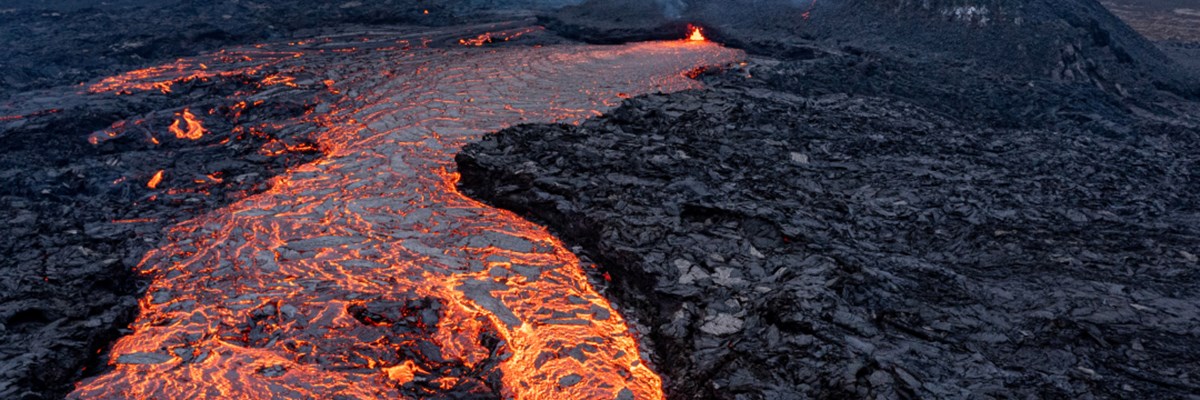
Iceland’s Volcanic Eruption 2023
A Complete Guide to the New Icelandic Eruption in 2023
On the 10th of July just before 5 pm, the mountain Litli-Hrutur on the Reykjanes Peninsula began to erupt. This didn’t come as a surprise to Icelanders in the capital area, who had felt several earthquakes a day before the eruption started.
Like the previous eruptions in 2021 and 2022, the new volcano has caused quite a stir. It’s a unique chance to see molten lava up close, erupting out of the fissure and forming new landscapes in front of your eyes. In short, an experience you won’t soon forget.
This new eruption is stronger than the previous ones in Fagradalsfjall Volcano in 2021 and 2022. It has a crack that is 900 meters (half a mile) long, which has been spewing forth lava. However, the first two eruptions were easier to visit than this one, which is located further along the hiking trails.
But, for those who do make the trek out to the new volcano, you’ll likely never forget the experience. In this article, we’re going to go over everything you need to know if you’re planning on visiting the 2023 Icelandic eruption of Litli-Hrutur.
While we delve into the details of this mesmerizing event, those planning to witness the raw power of nature firsthand should check out our comprehensive guide on Iceland volcano eruption 2022. This detailed resource provides valuable insights into the eruption that took place in 2022, offering tips and information for those considering a visit to witness this extraordinary display of natural forces. From safety guidelines to the best vantage points, our guide on Iceland volcano eruption 2022 ensures that your experience is not only memorable but also well-informed. Dive into both guides, and let the expertise on past eruptions be your key to a safe and captivating adventure amidst Iceland's volcanic wonders.
Will Iceland’s Erupting Volcano Affect My Flight?
First things first, this volcanic eruption won’t be affecting any flights coming in or out of Keflavik International Airport. So, if you’re traveling to Iceland, you can breathe a sigh of relief.
In general, the current eruption of Litli-Hrutur is considered relatively minor, at least compared to the 2010 Eyjafjallajökull eruption that sent ash plumes into the atmosphere. So far, there has been little ash released in this eruption.
Where is the 2023 Icelandic Eruption Happening?
The new Icelandic eruption is occurring on the Reykjanes Peninsula, close to the site of both the 2021 and 2022 eruptions.
The location of Litli-Hrutur is about 4 kilometers (2.5 miles) to the northeast of Fagradalsfjall Volcano. To go to Litli-Hrutur and back, you must walk about 20 kilometers (12 miles) in total, which is longer than the walk to Fagradalsfjall Volcano.
Is it Safe to Visit the Icelandic Eruption?
So far, the 2023 Iceland volcanic eruption of Litli-Hrutur is safe to visit for travelers. Although, the site has been closed periodically due to bad weather.
Experts say that the Litli-Hrutur eruption could be much larger than the previous ones in Fagradalsfjall Volcano. It could be as much as ten times the size of the 2021 eruption and three times the size of the 2022 eruption. But if you’re planning on visiting the volcano when you’re in Iceland, there are some things you should consider.
The main safety factor surrounding this eruption is the fact that it produces a lot of gas that is harmful to breathe. This gas doesn’t smell, which is why you’ll see members of the ICE-SAR team walking around the area with gas detectors, monitoring the levels. Strong winds can blow it in different directions, and if there’s no wind, it will accumulate in low places and valleys. It can also cause fires in the surrounding vegetation, which releases smoke and lowers the overall air quality.
Before you go to Litli-Hrutur, you should check the air quality in the area to make sure it is safe. You should also look at the wind direction on the Icelandic Weather Office website before you choose a hiking route. It is better to walk with the wind behind you, so that there’s no gas being blown over the hiking trail. But if that happens, the Icelandic authorities will close the entire site anyway.
When you get to the site, you should keep a safe distance from the eruption. The lava under the ground is much bigger than what you can see on the surface, and there is a risk of another crack opening near Litli-Hrutur. If you get too close, you might step on unstable ground, which can be very dangerous.
How Long Will the Eruption Last?
At this time, no one is quite sure how long the eruption will last. Fagradalsfjall in 2021 lasted for 6 months, while the 2022 Meradalir eruption only lasted 18 days. But volcanoes are unpredictable, and we can’t be sure whether it will end tomorrow or in a few months.
How Can I Visit the Iceland’s Erupting Volcano?
This is the third volcanic eruption in the Reykjanes Peninsula in three years, and it offers a spectacular sight of lava fountains, glowing rivers, and steaming vents.
But visiting an active volcano is not without risks, and you need to be well prepared and follow the safety guidelines. In this section, we will tell you how you can visit Iceland’s erupting volcano and what you need to know before you go.
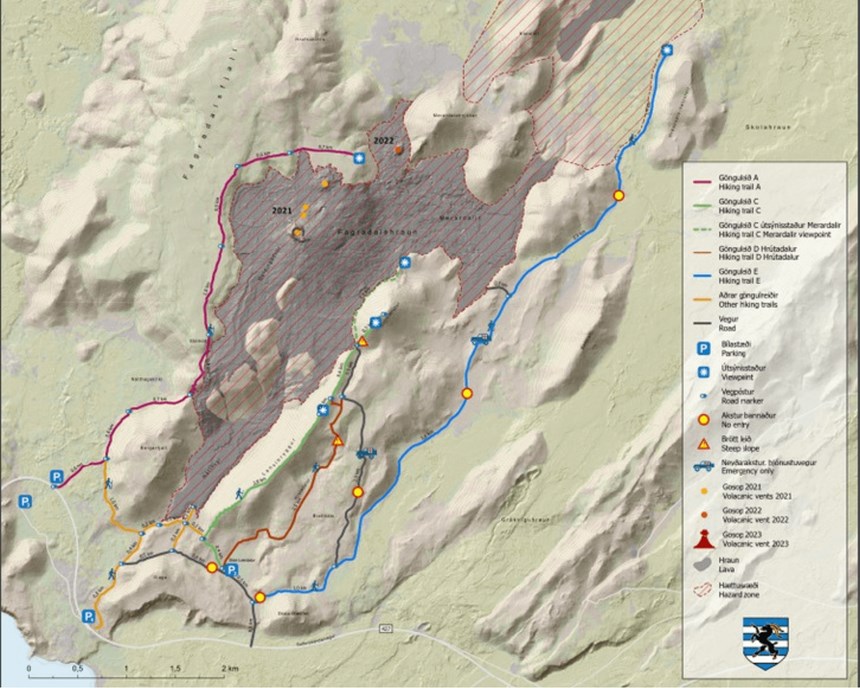
Where to Park your Campervan
If you’re traveling with a campervan in Iceland, the eruption site isn’t all that far from the Go Campers office.
There are designated parking areas at the trailhead of the volcano hike, created during the 2021 and 2022 eruptions. No roads go directly to the eruption site, so you will have to hike for about 20 kilometers (12 miles) round trip to get there.
The parking area for the Litli-Hrutur volcano in Iceland is marked as “P2” and is accessible from Route 427 east of Grindavík. The parking fee is 1000 ISK for cars, paid online (there are instructions once you’ve parked). It’s important that you use the designated parking area, and don’t leave your vehicle on the side of the road or drive off-road, since this is illegal and dangerous in Iceland.
The best hiking trail to take depends on the weather conditions, because the wind can affect how the gas and smoke from the eruption site move. If there are officials at the parking lots, please listen to their advice about which trail to take.
The Hike to the Volcano
The hike to the Litli-Hrutur volcano eruption site is challenging but rewarding. The best route to take is a 20-kilometer (12-mile) round trip, starting from Fagradalsfjall Parking P2. The hike takes about 6 to 8 hours, depending on your pace and how long you stay at the site.
The terrain is difficult, with some hills to climb and uneven surfaces. The trail follows a dirt road most of the way, but the last part is through an open lava field and up onto a small mountain. A good pair of hiking shoes are essential, and ones with good ankle support. The hike is not suitable for children or people with health problems.
What Do I Need to Take with Me to the Volcano?
Visiting the 2023 volcanic eruption in Iceland is an exciting activity, but due to the difficulty of the hike, you need to be well prepared and bring the right gear and clothing with you. Here are some of the things you need to take with you to the volcano:
- A backpack with enough food, water, and snacks for longer than you anticipate you’ll need.
- A power bank or extra batteries for your phone or camera.
- A first aid kit with bandages, antiseptic wipes, painkillers, and other essentials.
- A flashlight or headlamp in case it gets dark.
- A map or GPS device to navigate the trails.
- A whistle or flare in case of emergency.
- A hat, sunglasses, sunscreen, and lip balm to protect yourself from the sun.
- A warm hat, gloves, scarf, and socks to keep yourself warm.
- A windproof and waterproof jacket and pants to keep yourself dry.
- Layers of clothing that you can adjust according to the temperature.
- Good hiking shoes with sturdy soles and ankle support.
How Do I Visit the Volcano Safely?
Volcanoes are unpredictable and dangerous natural phenomena. You need to be aware of the potential hazards and follow the safety precautions when visiting a volcano. Here are some tips on how to visit the volcano safely:
- Check the weather forecast and volcanic activity before you go. You can find updated information on the Safe Travel website and the Icelandic Met Office website. But in general, you should be prepared for all types of weather – rain, fog, cold, wet, and windy.
- The hike is long, so pace yourself and take your time.
- Listen to local authorities on site and follow their instructions. They may advise you to evacuate or take shelter depending on the situation.
- Stay on marked trails and avoid valleys or low-lying areas where gas pollution can accumulate.
- Keep a safe distance from the eruption site and do not get too close to the lava flow or fissure.
- Don’t walk across any newly formed lava – it might look solid, but there is molten lava just below the surface and you can easily fall through. The rescue team won’t risk their own lives to save someone who is walking across lava.
- Walk towards the eruption site with the wind at your back, and on the way back, face the wind to minimize gas exposure.
- If you feel any discomfort or symptoms such as coughing, wheezing, chest pain, eye irritation, or skin rash, seek medical attention as soon as possible.
Related articles
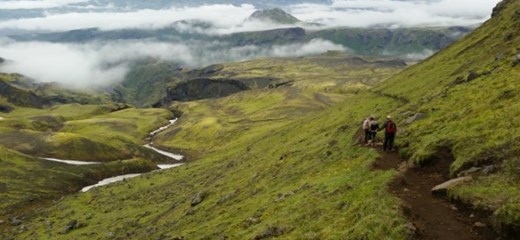
Hiking Fimmvörðuháls With a Campervan
Discover how you can hike the famous Fimmvörðuháls Pass in South Iceland if you've rented a campervan.
Read more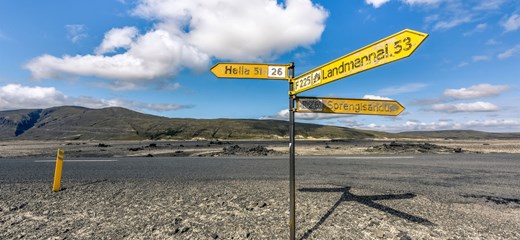
The Sprengisandur Route
This comprehensive guide to the Sprengisandur Route in Iceland, or F26, has been designed to prepare you for traversing Iceland’s interior with your 4x4 campervan.
Read more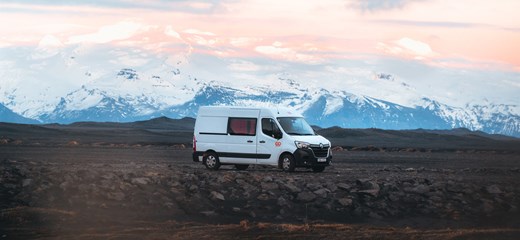
Iceland’s Ring Road: Clockwise or Counterclockwise?
Wondering which direction to drive Iceland’s Ring Road? This article will help you decide once and for all whether you choose clockwise or counterclockwise.
Read more James Taylor
James Taylor






